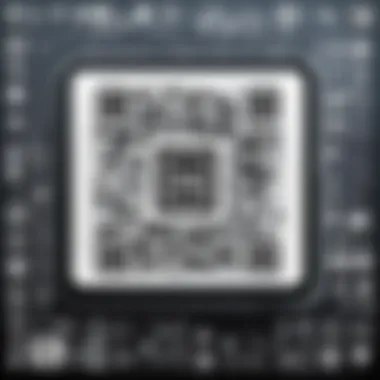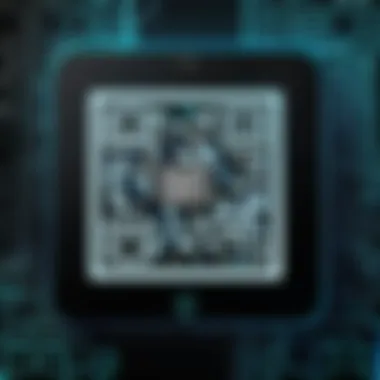Exploring QR Code Decoders for Android Devices


Intro
The emergence of QR codes has revolutionized various aspects of daily life, especially in the realm of technology and digital transactions. As smartphones have become ubiquitous, the capability to decode these codes has shifted from niche functionality to a standard expectation among users. Consequently, understanding QR code decoders becomes essential for anyone looking to navigate the modern digital landscape effectively.
This article provides a deep dive into QR code decoders specifically for Android devices, dissecting their capabilities, applications, and significance in everyday interactions. By analyzing popular decoders, such as ZXing Decoder and QR Code Reader by Scan, we will explore the myriad features they offer and the trends shaping their future.
Overview of the Technology
QR code decoders use specialized software to interpret the data contained within QR codes. These codes can store URLs, text, or other information that a mobile device can read swiftly and efficiently. The technology operates based on image processing, transforming visual patterns into actionable data.
Key Specifications
- Compatibility: Most QR code decoders are designed to work seamlessly with Android operating systems, ensuring a broad range of device compatibility.
- Speed: The best decoders emphasize quick scanning feedback, allowing users to access the information almost instantaneously.
- Data Capacity: Different QR code decoders can handle varying amounts of data; choosing an appropriate one depends on the user's specific needs.
Unique Selling Points
- User-Friendly Interfaces: Many QR code decoders come with intuitive designs, making them accessible for users of all technical levels.
- Multi-Functionality: Besides decoding, many apps integrate additional features like saving history or sharing scanned information via social media.
- Offline Functionality: Some decoders allow users to access stored information at any time, even without an internet connection. This feature enhances usability in various environments.
Design and Build Quality
The design of QR code decoders plays an essential role in user experience. Developers often focus on creating efficient interfaces that appeal to a broad audience.
Material Used
Although QR code decoders are software-based, the quality of the app design directly affects functionality. Apps built with clean coding and efficient structures ensure better performance.
Ergonomics and Usability
For Android devices, usability hinges on smooth integration with touch screens. Features such as adjustable scanning frames and customizable settings allow for improved interaction, enabling users to scan with ease.
"The integration of sophisticated image-processing algorithms ensures clarity and precision in decoding QR codes, making technology accessible to everyone."
Understanding how QR code decoders operate on Android devices not only enhances personal technology use but also reflects on broader digital transaction trends. With this foundational knowledge, readers can optimize their use of scanning technology in their everyday lives.
Foreword to QR Codes and Their Relevance
QR codes, short for Quick Response codes, have established themselves as an integral part of modern digital communication. Their versatility and ease of use allow for seamless interactions between the physical and digital worlds. In the context of this article, understanding QR codes and their relevance is crucial. They serve not only as tools for businesses for marketing and data sharing but also empower consumers in engaging with products and services more efficiently.
With the rapid rise of touchless technology due to recent global events, QR codes have seen a dramatic uptick in usage. They simplify access to information, facilitate cashless transactions, and enable direct connections to websites or social media profiles with a simple scan from a smartphone. Such features underscore the importance of mastering QR code decoders for Android devices.
Definition and Origin
QR codes were invented in 1994 by Denso Wave, a subsidiary of Toyota. Originally designed for tracking parts in manufacturing, their quick readability and capacity to store various types of data led to broader applications. A QR code can hold URLs, text, images, and even contact information.
The initial purpose tailored to the automotive industry has morphed into a global phenomenon. Today, QR codes are ubiquitous—from product packaging to restaurant menus—inviting users to simply scan and engage. They have evolved to accommodate enhanced capabilities, such as dynamic codes that can be updated post-creation.
Current Trends in QR Code Usage
The applications of QR codes have expanded significantly over the last few years. A survey in 2022 indicated a 70% increase in consumer usage of QR codes during the pandemic. Here are several notable trends:
- Retail and E-commerce: Many brands utilize QR codes for promotions, loyalty programs, and customer engagement.
- Safe Transactions: In the realm of contactless payments, QR codes provide a secure way to handle transactions while minimizing physical contact.
- Augmented Reality: Some modern QR codes link users to augmented reality platforms, enriching the consumer experience.
Moreover, QR codes have gained traction in sectors such as healthcare, where they are used for tracking patient records and vaccination status. As technology advances, QR codes continue to adapt, integrating with mobile applications and other digital services, retaining their position as essential tools in our increasingly digital lifestyles.


Understanding QR Code Decoders
Understanding QR code decoders is essential for grasping their role in current technology. QR codes have transitioned from being a mere novelty to a practical tool widely used across various sectors. A QR code decoder enables users to interact seamlessly with this technology. They provide significant benefits including fast access to information and ease in transaction processes. In addition, familiarity with decoders allows users to navigate the digital landscape more confidently.
What is a QR Code Decoder?
A QR code decoder is a software application or built-in feature on devices that translates the information encapsulated in a QR code into a human-readable format. When a scanner captures an image of a QR code, the decoder interprets the patterns and transforms them into data. This data could lead to a website, trigger a payment process, or provide contact information, among other functionalities. Most smartphones today come equipped with native QR code decoders, making the technology accessible to many.
How QR Code Decoders Work
QR code decoders operate through several core processes. Initially, the camera on the smartphone captures the QR code. Next, the decoder analyzes the captured image, recognizing the black and white patterns that make up the code. This recognition process involves identifying the position markers, alignment patterns, and timing patterns that are unique to QR codes.
Once deciphered, the data is extracted and processed. This could involve displaying a URL, adding a contact, or initiating an app. Modern QR code decoders often employ error correction techniques to ensure that, even if a QR code is partially damaged or obstructed, they can still extract the adequate information. Users benefit from these decoders being quick and efficient, reducing the need for manual data entry.
Importance of QR Code Decoders in Today’s Technology
QR code decoders hold significant importance in today's fast-paced digital ecosystem. They facilitate contactless interactions, which have gained prominence especially during the pandemic. The ability to quickly access digital content or trigger transactions through a simple scan has made them essential tools for businesses and consumers alike.
Moreover, with the rise of e-commerce and mobile payment systems, QR codes are becoming a standard part of transactions. They link physical products to digital experiences, providing a bridge between the offline and online worlds. The versatility of these decoders also allows their application across multiple domains, from marketing to logistics.
"The importance of QR code decoders extends beyond mere utility; they represent a shift towards efficient digital interactions."
Understanding how QR code decoders function contributes to recognizing their potential applications and advantages. They are not just tools; they are enablers of a more connected world.
Types of QR Code Decoders for Android
Understanding the types of QR code decoders for Android is crucial, as it influences the effectiveness and efficiency of scanning. QR code decoders vary significantly in terms of functionality, user experience, and adaptability to different types of QR codes. Recognizing the differences can help users select the most suitable option, enhancing their interaction with QR codes.
Native QR Code Decoders in Android OS
Most modern Android devices come equipped with native QR code decoders integrated directly into their operating systems or camera applications. This means that users do not need to install any external apps to scan QR codes. The native capability is convenient and often reliable for basic scanning tasks. The functionality typically includes recognizing QR codes and linking users directly to the corresponding content, whether it be a website URL, Wi-Fi credentials, or other data.
Using the native QR code decoder usually allows for seamless integration with other device features, such as contactless payments or quick access to specific app functionalities. However, while these built-in options are effective for everyday usage, they might lack advanced features found in dedicated third-party apps.
Third-Party QR Code Decoder Applications
For users seeking more advanced functionalities, third-party QR code decoder applications offer a range of features not always available in native solutions. These applications are designed with enhanced capabilities such as:
- Customization options for scan results and user interface
- Batch scanning capabilities for scanning multiple codes at once
- History tracking of scanned codes
- Supports a variety of formats, including visual QR codes and dynamic codes
- Integration with other apps, such as note-taking or social media
Some popular third-party applications include QR Code Reader by Scan and QR Code Scanner by Gamma Play, each with different strengths that may align better with specific user needs. Depending on the requirements, users might find that installing a third-party app optimizes their experience significantly.
Comparison of Popular QR Code Decoders
When choosing a QR code decoder, it is beneficial to compare popular QR code decoders to determine which one best fits your needs. Here are some criteria to consider when making this comparison:
- Scan speed and accuracy
Apps like QR Code Reader tend to have faster scan times and consistent accuracy when recognizing codes. - User interface and experience
An intuitive interface can significantly enhance ease-of-use. For instance, QR Code Scanner has a straightforward layout that many users appreciate. - Support for Different QR Code Formats
Certain decoders may not recognize all QR code formats, which can limit functionality. Check if the app supports multiple code types. - Accessibility features
For users with disabilities, it's vital to evaluate how accessible the app is. Some apps include voice feedback and larger buttons.
In summary, the effectiveness of QR code decoders depends on various factors, including purpose and user preference. Exploring the options available in both native and third-party applications allows users to enhance their QR code scanning capabilities, ultimately benefiting their digital interactions.
Features to Look for in a QR Code Decoder
Choosing a QR code decoder for Android requires careful consideration of its features. Identifying the right attributes can enhance user experience and maximize the efficiency of scanning. In this section, we’ll analyze critical features to help users select the best QR code decoder for their needs.
Scan Speed and Accuracy


Scan speed and accuracy are paramount when evaluating a QR code decoder. Fast scanning capabilities allow users to quickly retrieve information with minimal effort. Slow responsiveness can lead to frustration, especially in high-demand situations like events or retail environments. Additionally, accuracy in recognizing QR codes contributes to successful transactions and exchanges. A decoder that frequently misreads codes can result in wasted time and potential errors in data retrieval. This is why when comparing options, checking user reviews focusing on speed and precision is essential.
User Interface and Experience
The user interface significantly influences the overall experience of interacting with a QR code decoder. A simple, intuitive design allows users to navigate the app with ease. Ideally, the scanner should have clear buttons and minimal distractions. Some applications also offer features like a history log of previously scanned codes, which can be beneficial for users who scan frequently. Checking screenshots or demo videos can provide insights into how user-friendly an app is before installation.
Support for Different QR Code Formats
Not all QR code decoders are created equal when it comes to format compatibility. It is crucial to choose a decoder that supports various QR code formats. Standard QR codes are commonly used, but there are also other formats like iQR codes or Micro QR codes. Some decoders offer additional features that allow them to interact with specific formats utilized in different contexts, such as advertising or event ticketing. Ensuring the decoder you select can efficiently handle various formats will enhance its usefulness.
Accessibility Features
The importance of accessibility in technology cannot be overstated. Many users may have specific needs when it comes to using software applications. A QR code decoder that incorporates accessibility features, such as voice-over support or adjustable text sizes, makes the tool more usable for a wider audience. Moreover, apps that comply with accessibility standards not only show a commitment to inclusivity but also provide a better experience for those with disabilities. Researching the accessibility options available in different decoders can lead to better identification of a product that meets diverse user needs.
Key Takeaway: Selecting the right QR code decoder involves looking for fast scanning speed, user-friendly interfaces, broad format support, and necessary accessibility features. These aspects significantly influence the efficiency and satisfaction of users in their QR code scanning experience.
Downloading and Installing QR Code Decoders
The process of downloading and installing QR code decoders on Android devices is crucial for users looking to harness the full potential of QR codes. As these codes become more prevalent in daily interactions, understanding how to efficiently acquire and set up a decoder can vastly improve user experience. A dependable QR code decoder not only augments the ability to scan codes but also enhances security and functionality in handling scanned information. Users should understand the different sources available, the installation process itself, and the necessary permissions required for optimal performance.
Finding Reliable Sources
In today’s app-driven world, finding a reliable source for downloading QR code decoder applications is paramount. Users should primarily seek trusted platforms such as the Google Play Store. This platform has a vetting process that reduces the risk of downloading malicious apps. Additionally, exploring the app's ratings and user reviews will provide insight into its effectiveness.
Alternate sources like APKs from reputable websites may also be considered, but they come with additional risks. Only download APKs from trusted sites, as they are often less regulated than app stores. Exploring community discussions on platforms like Reddit can provide recommendations and warnings about specific apps.
Installation Process on Android Devices
Installing a QR code decoder is generally straightforward, especially through the Google Play Store. Here’s how:
- Open the Google Play Store on your Android Device.
- In the search bar, type the name of the desired QR code decoder.
- Review the search results, focusing on well-rated apps.
- Tap the Install button to download the app to your device.
Once the installation is complete, the app icon will appear in the app drawer. Users can simply tap the icon to launch the application.
As a note, some third-party apps may require users to allow installation from unknown sources. This setting can be found in the device's security options, but be cautious with this option as it may expose your device to risks.
Initial Setup and Permissions
After installation, the initial setup involves granting necessary permissions for the app to work effectively. Most QR code decoder apps require access to the device camera, which is crucial for scanning codes. Upon launching the app, a prompt will typically appear to request permission. Users should:
- Confirm camera access to enable scanning functionality.
- Review additional permissions that may improve app performance, such as access to storage for saving scanned data.
It is essential for users to carefully read each permission's purpose before granting access. Some apps may also offer features that allow scanning from images saved in the gallery, enhancing versatility.
By ensuring that the app is correctly installed and permissions are set appropriately, users can maximize the utility of QR code decoders on their Android devices.
Using QR Code Decoders Effectively
Using QR code decoders effectively is essential for maximizing the value derived from this technology. Understanding how to utilize these tools to their full potential can lead to quicker access to online content, streamlined payments, and enhanced user experiences. This section will navigate through best practices, common issues, and security concerns associated with scanning QR codes, providing readers with a comprehensive guide to optimize their interactions with QR code decoders.
Best Practices for Scanning QR Codes
Employing effective techniques while scanning QR codes is vital. Here are some best practices to enhance the scanning experience:


- Stay Steady: Hold the device steady while scanning. Movement can disrupt the camera's ability to focus on the QR code.
- Good Lighting: Ensure there is adequate light for the camera to capture the QR code clearly. Poor lighting can lead to scanning errors.
- Clean the Camera Lens: Regularly check and clean the camera lens. A dirty lens can result in blurred images, making decoding difficult.
- Use the Right Decoder: Choose a QR code decoder that is well-suited for your needs. Some may offer advanced features such as history tracking or integration with other apps.
Following these practices can significantly reduce scanning failures and lead to quicker information retrieval.
Troubleshooting Common Scanning Issues
Despite its simplicity, issues can arise when scanning QR codes. Here are common problems and their solutions:
- Code Not Detected: If the code is not detected, try moving closer or adjusting the angle of your device. Some QR codes may require specific distances for optimal scanning.
- Error Messages: If an error message appears after scanning, ensure that the QR code is valid and functional. This can involve verifying with the source that issued the QR code.
- App Not Responding: If the decoder app freezes or crashes, close the app and reopen it. If the problem persists, consider reinstalling the app to resolve potential bugs.
Awareness of these issues helps users to handle problems effectively without becoming frustrated.
Security Considerations When Scanning QR Codes
Security is a major concern when using QR codes. Many users may be unaware of the potential risks involved. Here are some important considerations:
- Verify Source: Only scan QR codes from trusted sources. Scanning codes from unknown or suspicious locations can lead to phishing scams or malicious sites.
- Look for HTTPS: Before entering sensitive information, ensure that the link opened by the QR code is secure (look for HTTPS in the URL); this adds a layer of protection against data theft.
- Use Security-Focused Apps: Opt for QR code decoders that prioritize user security by scanning for malicious links or prompting for additional verification.
By acknowledging these risks, users can enjoy the benefits of QR codes with greater peace of mind.
"Using QR code decoders effectively requires attention to detail and knowledge of best practices, common issues, and security concerns to navigate this technology safely and efficiently."
The Future of QR Code Decoders
As technology continues to advance, QR code decoders evolve, becoming more integral to various sectors. Their future is marked by significant innovation driven by both consumer demand and industry trends. Understanding the path ahead for these tools reveals their growing importance in digital interactions and commerce.
Emerging Technologies and Innovations
The next generation of QR code decoders will incorporate emerging technologies such as augmented reality (AR) and artificial intelligence (AI). These advancements will enhance how users engage with QR codes, making the process more interactive and dynamic. For instance, a user scanning a QR code with an AR integration may see additional contextual information, graphics, or even engaging animations linked to the scanned code. This provides not just data but a rich media experience, increasing user engagement significantly.
Moreover, the integration of AI can improve accuracy and speed in decoding. Machine learning algorithms can learn from user interactions, adapting and optimizing the scanning experience over time. This personalization can lead to better recognition of complex codes and even the ability to predict which information the user may find most relevant.
The Role of QR Codes in Contactless Interactions
The COVID-19 pandemic has intensified the shift toward contactless solutions. QR codes serve as a bridge in this evolving landscape, enhancing safety and convenience in transactions. For restaurants, customers can view menus and place orders via QR codes. Retailers are also adopting this technology for product information and promotions.
As contactless payments become the norm, QR code decoders will play a pivotal role. Users will expect seamless transactions where scanning a QR code instantly completes a payment without physical contact. This trend not only improves convenience but also aligns with a growing emphasis on health and safety in public interactions.
Potential Developments in Mobile Security
As QR codes proliferate, security concerns will escalate. Future decoders must integrate advanced security features to combat fraud and ensure user safety. One approach could be adopting blockchain technology, which offers secure tracking of transactions and prevents unauthorized code generation.
Additionally, robust authentication processes may become standard, where users need to verify the source of a QR code before scanning it. This could involve using facial recognition or multi-factor authentication methods for extra security.
Users also need to be educated about common scams involving QR codes. A well-informed user base can significantly reduce the risks associated with fraudulent QR codes.
Finale
The conclusion of this article is crucial as it synthesizes the knowledge gathered concerning QR code decoders for Android devices. It emphasizes the significant role these tools play in modern technology and highlights their growing relevance in various sectors. Recognizing that QR codes have become ubiquitous in marketing, payments, and information sharing, understanding their decoders enhances user experience and security. As users rely more on mobile devices to interact with QR codes, the efficiency of the decoder directly impacts the effectiveness of their actions.
Through this article, we have explored key insights regarding how QR code decoders function, the different types available, and best practices for optimal use. This understanding guides users towards making better choices in selecting and utilizing their preferred QR code decoders, ultimately enriching their digital experience.
Recap of Key Insights
The journey through this guide has provided a comprehensive overview of QR code decoders. One of the major insights is the variety of options available from native integration in Android OS to third-party applications. Each option carries its own distinct features and functionalities, catering to different user preferences and needs.
Another important point highlighted is the critical features necessary for an effective QR code decoder. Speed and accuracy are paramount, as they ensure a seamless experience during crucial interactions such as payments or accessing information. Furthermore, accessibility features and user-friendly interfaces enhance usability across diverse demographics.
In addition, we addressed the importance of downloading, installing, and configuring QR code decoders correctly. Choosing reliable sources for applications is essential to avoid security risks. This not only safeguards personal data but also ensures the decoder works flawlessly on Android devices.
Final Thoughts on QR Code Decoders for Android
Looking ahead, QR code decoders will continue to evolve, influenced by emerging technologies and an increase in digital transactions. The integration of innovations such as augmented reality and advanced security measures could enhance their functionalities significantly. As the demand for contactless interactions rises, organizations and users alike must consider the impact of QR code technology on their daily lives.







